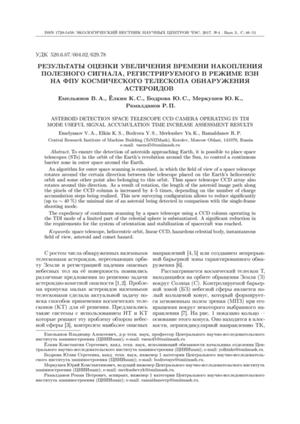Результаты оценки увеличения времени накопления полезного сигнала, регистрируемого в режиме ВЗН на ФПУ космического телескопа обнаружения астероидов
УДК
520.6.07/004.02/629.78Аннотация
Рассмотрен алгоритм сканирования космического пространства, при котором поле зрения космического телескопа (КТ) вращается вокруг некоторого направления между КТ, установленным на орбите обращения Земли вокруг Солнца, и некоторой точкой, также принадлежащей этой орбите. Вокруг указанного направления вращается ПЗС-линейка фоторегистрирующего устройства, установленного на КТ. За счёт вращения увеличивается длина пути изображения астероида в пикселах НС в 4-5 раз в зависимости от реализуемого количества шагов накопления заряда. Указанный эффект существенно (до
Ключевые слова:
космический телескоп, гелиоцентрическая орбита, ПЗС-линейка, опасное небесное тело, мгновенное поле зрения, астероидно-кометная опасностьБиблиографические ссылки
- Шустов Б.М., Шугаров А.С., Нароенков С.А., Прохоров М.Е. Астрономические аспекты космических угроз: новые задачи и подходы к проблеме астероидно-кометной опасности после Челябинского события 15 февраля 2013 г. // Астрономический журнал. 2015. Т. 92. № 10. C. 867-880. [Shustov B.M., Shugarov A.S., Naroenkov S.A., Prokhorov M.E. Astronomicheskie aspekty kosmicheskikh ugroz: novye zadachi i podkhody k probleme asteroidno-kometnoy opasnosti posle Chelyabinskogo sobytiya 15 fevralya 2013 g. [Astronomical aspects of space threats: new tasks and approaches to the problem of asteroid-comet danger after the Chelyabinsk event February 15, 2013]. Astronomicheskiy zhurnal [Astronomical Journal], 2015, vol. 92, no. 10, pp. 867-880. (In Russian)]
- Емельянов В.А., Меркушев Ю.К., Рамалданов Р.П., Савельев М.И. Имитационные модели функционирования космических телескопов предупреждения о падении на Землю малых ОНТ // Космонавтика и ракетостроение. 2016. № 7. С. 97-107. [Emel'yanov V.A., Merkushev Yu.K., Ramaldanov R.P., Savel'ev M.I. Imitatsionnye modeli funktsionirovaniya kosmicheskikh teleskopov preduprezhdeniya o padenii na Zemlyu malykh ONT [Simulation models of the functioning of space telescopes warning of the fall of small ONTs to the Earth]. Kosmonavtika i raketostroenie [Astronautics and rocket engeneering], 2016, no. 7, pp. 97-107. (In Russian)]
- Bakut P.A., Vygon V.G., Shargorodskii V.D., Shumilov Yu.P. Statistical synthesis of the optimal algorithm for detecting celestial objects observed in the optical band // Journal of Communications Technology and Electronics. 2009. Vol. 54. No. 8. P. 925-936.
- Генова A.Л., Данэм Д.В. Использование Венеры для расположения космических обсерваторий с целью обнаружения потенциально опасных астероидов // Космические исследования. 2010. Т. 48. № 5. С. 433-439. [Genova A.L., Danem D.V. Ispol'zovanie Venery dlya raspolozheniya kosmicheskikh observatoriy s tsel'yu obnaruzheniya potentsial'no opasnykh asteroidov [Use of Venus to locate space observatories to detect potentially dangerous asteroids]. Kosmicheskie issledovaniya [Space research], 2010, vol. 48, no. 5, pp. 433-439. (In Russian)]
- Прохоров М.Е., Шугаров А.С. Система обнаружения Дневных Астероидов (СОДА), Семинар "Средства и методы обнаружения опасных небесных тел", Москва, 25 марта 2015, ИНАСАН. [Prokhorov M.E., Shugarov A.S. Sistema obnaruzheniya Dnevnykh Asteroidov (SODA) [Daylight Asteroids Detection System (SODA)]. In: Proc. of seminar "Sredstva i metody obnaruzheniya opasnykh nebesnykh tel" [Seminar "Means and Methods for Detection of Dangerous Celestial Bodies"], Moscow, March 25, 2015, INASAN. (In Russian)]
- Емельянов В.А., Савельев М.И., Ёлкин К.С., Бодрова Ю.С., Меркушев Ю.К., Рамалданов Р.П. Показатели целевой эффективности системы оперативного предупреждения об астероидно-кометной опасности "Космический барьер" // Технологии гражданской безопасности. 2016. Т. 13. № 1. C. 44-49. [Emel'yanov V.A., Savel'ev M.I., Elkin K.S., Bodrova Yu.S., Merkushev Yu.K., Ramaldanov R.P. Pokazateli tselevoy effektivnosti sistemy operativnogo preduprezhdeniya ob asteroidno-kometnoy opasnosti "Kosmicheskiy bar'er" [Indicators of the target efficiency of the operational warning system for asteroid-comet hazard "Space barrier"]. Tekhnologii grazhdanskoy bezopasnosti [Civil safety technologies], 2016, vol. 13, no. 1, pp. 44-49. (In Russian)]
- Емельянов В.А. Перспективы использования космических телескопов для обнаружения малых опасных тел // Космонавтика и ракетостроение. 2008. № 2. C. 117-122. [Emel'yanov V.A. Perspektivy ispol'zovaniya kosmicheskikh teleskopov dlya obnaruzheniya malykh opasnykh tel [Prospects of using space telescopes for detecting small dangerous bodies]. Kosmonavtika i raketostroenie [Cosmonautics and rocket engeneering], 2008, no. 2, pp. 117-122. (In Russian)]
Скачивания

Загрузки
Даты
Поступила в редакцию
Принята к публикации
Публикация
Как цитировать
Лицензия
Copyright (c) 2017 Емельянов В.А., Ёлкин К.С., Бодрова Ю.С., Меркушев Ю.К., Рамалданов Р.П.

Это произведение доступно по лицензии Creative Commons «Attribution» («Атрибуция») 4.0 Всемирная.


